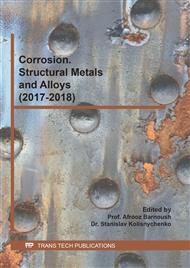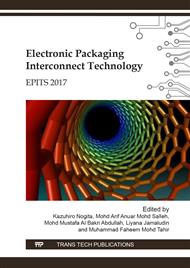p.40
p.46
p.51
p.56
p.61
p.66
p.72
p.77
p.83
Effect of Phosphorus and Nickel on Electrochemical Migration of Sn-3Ag-0.7Cu Solder Paste in Simulated Body Fluid
Abstract:
Electrochemical migration (ECM) behaviour of Sn-3Ag-0.7Cu and Sn-3Ag-0.7Cu-0.03P-0.005Ni solder alloys were investigated using simulated body fluid (SBF) solution. In electronic devices, ECM phenomenon potentially leads to incompetence or failure of the whole devices. According to water drop test (WDT), mean-time-to-failure (MTTF) of commercially used Sn-3Ag-0.7Cu solder alloy was prolonged with addition of phosphorus (P) and nickel (Ni) as alloying elements. According to microstructure of each solder paste alloy which was observed using field emission scanning electron microscope (FESEM), dendrite structure in Sn-3Ag-0.7Cu-0.03P-0.005 Ni solder was lesser than in plain the Sn-3Ag-0.7Cu. This phenomenon suggested that presence of P and Ni retarded the growth of dendritic thus improved its corrosion resistance. Therefore, Sn-3Ag-0.7Cu-0.03P-0.005Ni possessed a good corrosion resistance in SBF medium.
Info:
Periodical:
Pages:
61-65
Citation:
Online since:
April 2018
Price:
Сopyright:
© 2018 Trans Tech Publications Ltd. All Rights Reserved
Share:
Citation:



